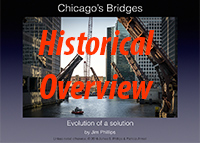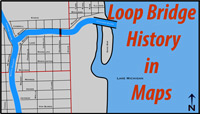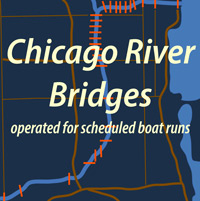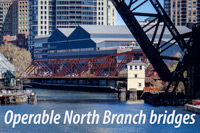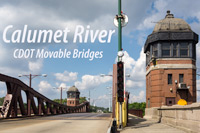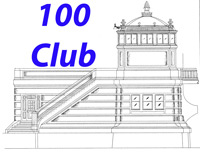The Chicago Type, Fixed Trunnion, Double Leaf, Bascule Bridge was based on a medieval concept. Many refinements were added to this concept during a particularly fertile time in Chicago bridge design. The individuals listed below played key roles in the development of the Chicago Type bridge between 1900 and 1930.
Alexander F. von Babo (1854 - 1920)
Mr. von Babo was born in Germany. He immigrated to the U.S. in 1886.
Mr. von Babo was involved in the effort that identified the fixed trunnion bascule bridge as “Chicago's bridge” in 1900. And on August 29, 1911, he was granted patent No. 1,001,800. This patent was significant because it moved the rack from the outside of the bridge trusses to the inside. This innovation paved the way for the use of more attractive and varied trusses on the second generation bridges. He worked for the city until 1915.
He worked directly on the West Washington Boulevard bridge and his name appears on the bridge plaques on the West Lake and West Monroe Street bridges. However, the impact of his design innovation is much wider than his connection to specific bridges.
****
John E. Ericson (1858 - 1927)
Mr. Ericson was born in Sweden in 1858. He received his education at the Royal Polytechnic Institute in Stockholm and immigrated to the U.S. in 1881.
Mr. Ericson served as city engineer from 1897-1927 with the exception of four years her served in a consulting capacity. His major contribution to the bridges in Chicago was his leadership in the process that identified the fixed trunnion bascule bridge as THE BRIDGE for Chicago in 1900.
The bridges influenced by Mr. Ericson include: W Lake St; N Franklin St; N Wells St; W Madison St.
****
Joseph B. Strauss (1870 - 1938)
Mr. Strauss was a U.S. born engineer. He began his career at New Jersey Iron and Steel and the Chicago Public Works Department before opening his own firm, The Strauss Bascule Bridge Company in 1902.
The Strauss Company designed two of the eighteen bridges in this group - W. Jackson Blvd and N. Lake Shore Dr. The major impact Mr. Strauss had on Chicago bridges was his 1913 patent infringement lawsuit against the city of Chicago. Chicago eventually lost the suit and paid the Strauss company $350,000. This lawsuit made the city more determined than ever to avoid patented designs in their bridges. (Interestingly enough, Strauss lost a similar lawsuit against the city of Seattle a few years later.)
Mr. Strauss had an illustrious career where the crowning achievement was his work as lead engineer on the Golden Gate Bridge in San Francisco.
****
Thomas G. Pihlfeldt (1858 - 1941)
Mr. Pihlfeldt was born in Norway, educated in Germany, and immigrated to the U.S. in 1879.
He began his career in the U.S. as a draftsman for Chicago engineering firms eventually making his way to the Chicago Division of Bridges in 1894.
His most innovative work came on the replacement of the swing bridges at West Lake Street and North Wells Street. Both of these bridges carried a high volume of train traffic on their upper deck. It was important to minimize the disruption in this train traffic.
Pihlfeldt's solution was to maintain train traffic on the old swing bridges while the new bascule bridges were built with the leaves in the vertical (open) position. Once the new bridge was completed, the old bridge was rotated open, cut up, and removed via the river. The new bridge was then lowered into place. When the West Lake Street bridge was built in 1916, train traffic was interrupted for seven days. Six years later when the Wells Street Bridge was built, train traffic was interrupted for only three days.
T. G. Pihlfeldt's name can be found on bridge plaques at: W Washington Blvd; W Lake St; Du Sable Bridge at N Michigan Ave; N Franklin St; N Wells St; W Madison St; W Adams St; N La Salle St; N Clark St; N Wabash St.
****
Hugh E. Young (1883 - 1951)
Mr. Young's first association with a bridge along Wacker Drive was in 1916 when the bridge at West Lake Street was built. He worked for the city bridge engineering department and the Chicago Plan Commission during his career. Judging from the information on the bridge plaques, he transferred to the Plan Commission in 1928. He became more influential in bridge issues when Edward Bennett's position was eliminated in 1930. One of his first decisions following the departure of Bennett was to “modernize” the original design on the bridge tender houses of the North Lake Shore Drive bridge.
Mr. Young influenced the following bridges: W Lake St; W Monroe St; N Franklin St; Du Sable Bridge at N Michigan Ave; W Madison St; N Wells St; N Clark St; N Lake Shore Dr.
****
Edward H. Bennett (1874 - 1954)
Edward Bennett was born in England in 1874. He received his architectural education at the Ecole des Beaux-Arts in Paris. In 1903 he joined forces with Daniel Burnham in a design competition for West Point. Although their design for West Point was not chosen, a professional bond was formed. Their most significant collaboration for Chicago was the Plan of Chicago of 1909.
The primary focus of Bennett's long career was city planning. As a strong proponent of the City Beautiful Movement and as a result of his training in Paris, he worked to soften the hard edges of the city in the attempt to produce a more humane environment. In addition to the Chicago Plan, he developed plans for Detroit, Minneapolis, and Portland, Oregon, among others.
Bennett worked as a consultant with the Chicago Plan Commission until his position was eliminated in 1930. His impact on the bridges built between 1913 and 1930 along Wacker Drive is most obvious in the architectural details of the bridge tender houses, foundation facades, railings, and staircases. Although the bridges were designed and continually improved by the engineers, Mr. Bennett's contributions visually softened the utilitarian nature of the structures.
The bridges influenced by Mr. Bennett include: W Washington Blvd; W Jackson Blvd; W Lake St; W Monroe St; Du Sable Bridge at N Michigan Ave; N Franklin St; N Wells St; W Madison St; W Adams St; N La Salle St; N Clark St; N Wabash St.
****
Donald N. Becker (1888 - 1977)
Mr. Becker was born in Ithaca, NY and educated at Rensselaer Polytechnic Institute. He joined the Chicago Bridge Engineering Department in 1912 and worked there until 1943.
His most significant contribution to the Chicago bridge story was his paper entitled "Development of the Chicago Type Bridge," published in the February 1943 Proceedings of the American Society of Engineers.
Donald Becker's name can be found on bridge plaques at: W Adams St; N La Salle St; N Clark St; N Wabash St.
****

